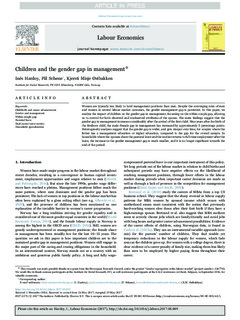| dc.description.abstract | Women are typically less likely to hold management positions than men. Despite the converging roles of men and women in several labour market outcomes, the gender management gap is persistent. In this paper, we analyse the impact of children on the gender gap in management, focussing on the within-couple gap, allowing us to control for both observed and unobserved attributes of the spouse. The main findings suggest that the gender gap in management increases considerably after the arrival of the first child. Nine years after the birth of the firstborn child, the male–female gap in management has increased by approximately 5 percentage points. Heterogeneity analyses suggest that the gender gap is wider, and gets steeper over time, for couples where the father has a management education or higher education, compared to the gap for the overall sample. In households where the spouses share the parental leave and the mother returns to full-time employment after the leave, the increase in the gender management gap is much smaller, and it is no longer significant towards the end of the period. | |
